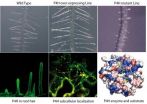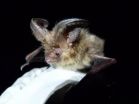UCLA team reports scalable fabrication of self-aligned graphene transistors, circuits
2011-06-19
(Press-News.org) Graphene, a one-atom-thick layer of graphitic carbon, has the potential to make consumer electronic devices faster and smaller. But its unique properties, and the shrinking scale of electronics, also make graphene difficult to fabricate and to produce on a large scale.
In September 2010, a UCLA research team reported that they had overcome some of these difficulties and were able to fabricate graphene transistors with unparalleled speed. These transistors used a nanowire as the self-aligned gate — the element that switches the transistor between various states. But the scalability of this approach remained an open question.
Now the researchers, using equipment from the Nanoelectronics Research Facility and the Center for High Frequency Electronics at UCLA, report that they have developed a scalable approach to fabricating these high-speed graphene transistors.
The team used a dielectrophoresis assembly approach to precisely place nanowire gate arrays on large-area chemical vapor deposition–growth graphene — as opposed to mechanically peeled graphene flakes — to enable the rational fabrication of high-speed transistor arrays. They were able to do this on a glass substrate, minimizing parasitic delay and enabling graphene transistors with extrinsic cut-off frequencies exceeding 50 GHz. Typical high-speed graphene transistors are fabricated on silicon or semi-insulating silicon carbide substrates that tend to bleed off electric charge, leading to extrinsic cut-off frequencies of around 10 GHz or less.
Taking an additional step, the UCLA team was able to use these graphene transistors to construct radio-frequency circuits functioning up to 10 GHz, a substantial improvement from previous reports of 20 MHz.
The research opens a rational pathway to scalable fabrication of high-speed, self-aligned graphene transistors and functional circuits and it demonstrates for the first time a graphene transistor with a practical (extrinsic) cutoff frequency beyond 50 GHz.
This represents a significant advance toward graphene-based, radio-frequency circuits that could be used in a variety of devices, including radios, computers and mobile phones. The technology might also be used in wireless communication, imaging and radar technologies.
INFORMATION:
AUTHORS:
The UCLA research team included Xiangfeng Duan, professor of chemistry and biochemistry; Yu Huang, assistant professor of materials science and engineering at the Henry Samueli School of Engineering and Applied Science; Lei Liao; Jingwei Bai; Rui Cheng; Hailong Zhou; Lixin Liu; and Yuan Liu.
Duan and Huang are also researchers at the California NanoSystems Institute at UCLA.
FUNDING:
The work was funded by grants from National Science Foundation and the National Institutes of Health.
JOURNAL:
The research was recently published in the peer-reviewed journal Nano Letters and is available online at http://bit.ly/iSDhNC.
END
ELSE PRESS RELEASES FROM THIS DATE:
2011-06-19
Fluctuations in climate can drastically affect the habitability of marine ecosystems, according to a new study by UCLA scientists that examined the expansion and contraction of low-oxygen zones in the ocean.
The UCLA research team, led by assistant professor of atmospheric and oceanic sciences Curtis Deutsch, used a specialized computer simulation to demonstrate for the first time that the size of low-oxygen zones created by respiring bacteria is extremely sensitive to changes in depth caused by oscillations in climate. These oxygen-depleted regions, which expand or ...
2011-06-19
College Park, MD (June 17, 2011)--A team of researchers has proposed a way to turn the material graphene into a semiconductor, enabling it to control the flow of electrons with a laser "on-off switch".
Graphene is thinnest and strongest material ever discovered. It's a layer of carbon atoms only one-atom thick, but 200 times stronger than steel. It also conducts electricity extremely well and heat better than any other known material. It is almost completely transparent, yet so dense that not even atoms of helium can penetrate it. In spite of the impressive list of promising ...
2011-06-19
Fish catches in Madagascar over the last half-century are double the official reports, and much of that fish is being caught by unregulated traditional fishers or accessed cheaply by foreign fishing vessels. Seafood exports from Madagascar often end up in a European recipe, but are a recipe for political unrest at home, where two-thirds of the population face hunger.
These are the findings of a recent study led by researchers from the University of British Columbia's Sea Around Us Project in collaboration with the Madagascar-based conservation organisation Blue Ventures. ...
2011-06-19
Co-author Professor Tony Bacic from the ARC Centre of Excellence in Plant Cell Walls, School of Botany and the Bio21 Institute, at the University of Melbourne, said plant cell walls (plant biomass) represent the world's largest renewable resource.
"Plant sciences have become a major new driver of international research due to their central role as renewable sources of transport fuels, as functional foods to improve human health, and as a source of raw materials for industrial processes," he said.
The study has been published in the current issue of the international ...
2011-06-19
RIKEN and the Japan Synchrotron Radiation Research Institute (JASRI) have successfully produced a first beam of X-ray laser light with a wavelength of 1.2 Angstroms. This light was created using SACLA, a cutting-edge X-ray Free Electron Laser (XFEL) facility unveiled by RIKEN in February 2011 in Harima, Japan. SACLA (SPring-8 Angstrom Compact free electron LAser) opens a window into the structure of atoms and molecules at a level of detail never seen before.
The use of ultra high-intensity X-ray free electron laser light to explore the miniature structure of matter, until ...
2011-06-19
The potentially lasting implications of day-to-day couple conflict on physical and mental well-being are revealed in a study published today in the journal Personal Relationships.
Until now research has concentrated on the immediate effects of romantic conflict, typically in controlled laboratory settings. In one of the first studies to look at the longer term, Professor Angela Hicks investigated the physiological and emotional changes taking place in couples the day after conflict occurred, specifically taking into account the differing styles of emotional attachment ...
2011-06-19
Luiz Tadeu Moraes Figuedo's paper on dengue in Brazil confirms the country's worsening trend; from 1999-2009, where cases rose at 6.2% per year and dengue deaths at 12.0% per year.
Carmen Perez and co-workers, reporting on dengue vector control in Puerto Rico, found that 83% of the costs ($1.97 per person per year) were funded by the lowest and often the least financed level of government: municipalities.
Examining dengue cases imported into France, Guy LaRuche documented the alarming increase in cases originating from Cote d'Ivoire from only one case in 2006-07 to ...
2011-06-19
Negative-pressure wound therapy probably does not promote healing. This is the conclusion of Frank Peinemann and Stefan Sauerland's meta-analysis in the current edition of Deutsches Ärzteblatt International (Dtsch Arztebl Int 2011; 108[22]: 381-9).
In negative-pressure wound therapy (NPWT), wounds are covered with an airtight film and an adjustable negative pressure is applied using an electronically controlled pump. The negative pressure drains wound exudate and is thought to promote healing. This procedure is used in particular for chronic persistent wounds and complicated ...
2011-06-19
A University of Exeter biologist has discovered a 'lost' species of bat breeding on the Isles of Scilly (UK). A pregnant female brown long-eared bat is the first of its species to be found on the islands for at least 40 years. It was discovered by Dr Fiona Mathews, Senior Lecturer at the University of Exeter, a postgraduate student and a team from the Wiltshire Bat Group.
The Scilly Isles Bat Group called in Dr Mathews and her team to help them find out more about bats on the islands. The researchers set up a radiotracking study, with funding from the Isles of Scilly ...
2011-06-19
Researchers headed by Joan Massagué at Memorial Sloan-Kettering Cancer Center (MSKCC) in New York and by María Macías at the Institute for Research in Biomedicine (IRB Barcelona) have identified a complex mechanism by which some proteins that are essential for life, called Smads, regulate the activity of genes associated with cancer. The fruit of three years of intense work, the study reports on the life cycle of this protein, a process that ensures that the protein is destroyed when it has completed its function. These results have been published today in the top journal ...
LAST 30 PRESS RELEASES:
[Press-News.org] UCLA team reports scalable fabrication of self-aligned graphene transistors, circuits

